8 Categories of Parkour Movement
/0 Comments/in Parkour/Freerunning Theory /by Holden HagermanI’m about to say something controversial in the Parkour community – Parkour is a system of technical movements. Now, before you go freaking out over this concept, I also believe Parkour can be a mindset of continuous improvement and creative problem solving to overcome mental obstacles and all that blah blah blah woo woo shit. However, it’s nearly impossible to coach a discipline based on intangible concepts like that. To have the absolute best Parkour classes in the Twin Cities, I knew I had to create a system that would work for anyone and everyone who comes in. So I want to share with you my creation of the system of technical movements that make up Parkour that we teach at Fight or Flight Academy and FoFa Online.
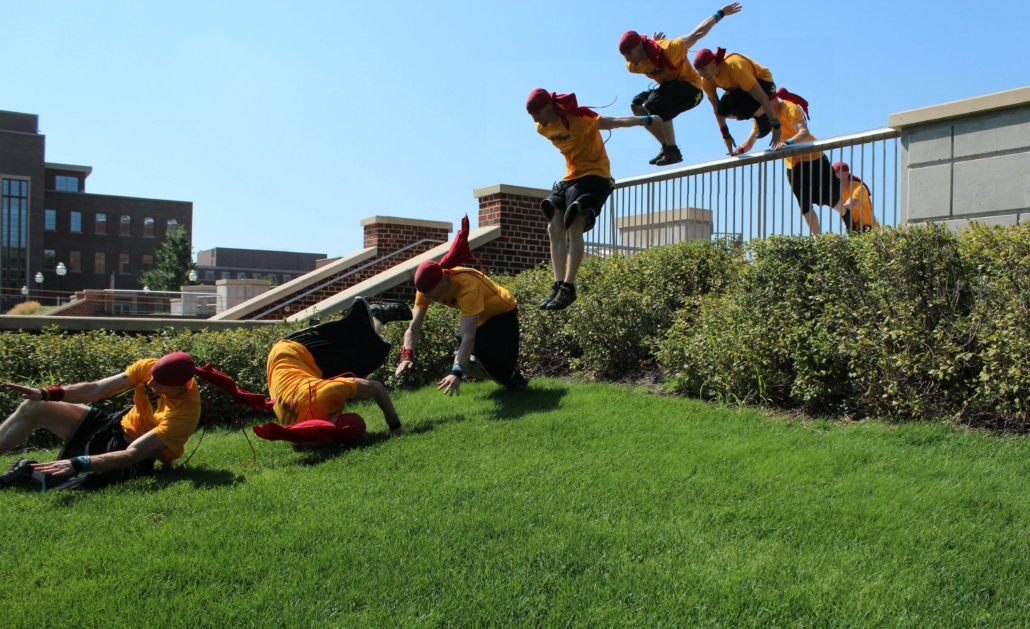
When I first started coaching Parkour 15 years ago, I knew I had to create a functional system for teaching. I was already a second degree black belt and had been teaching martial arts for years. Using the concepts of teaching martial arts (class style, drill setup, progressions, measurement systems, etc.) I started to create a standard teaching system for Parkour to have the best Parkour classes in the Twin Cities! Nothing like this had really been done before as most Parkour instructors didn’t have any previous coaching experience and just sort of made it up as they went. This was back around 2008 when most Parkour “coaches” had only been training themselves for a few years and had never taught anything else.
This system has been changed, tweaked, updated, and upgraded countless times over the years, but I believe the current setup works extremely well and covers things thoroughly. We split up everything into 8 categories and further break those down into smaller categories as one progresses through our levels. So let’s take a look at how we break things up one by one.
Our first category of movement –
LANDINGS

We start with landings because I believe that a good landing is the single most important technique in Parkour training. Nearly everything we do has some sort of impact involved and learning to absorb, redirect, or resist against that impact will save your body in the long run. Parkour is meant to be practiced for a lifetime, having good landings will allow that.
Our beginner program actually starts with learning to fall properly. As a Parkour practitioner, you WILL fall down at some point. Learning how to fall properly and safely is a good way to start your training. This also shows our students that it’s ok to fall! One of our big lessons starting with day one is that failure is ok and even necessary to the learning process. So the first thing we teach is a proper back, side, and front breakfall.
Next in our beginner landing curriculum is balance. We cover techniques of balancing while walking along an obstacle as well as standing perpendicular to the obstacle, which leads directly into the precision jump. All of this is taught at ground level to start with. Perfect the technique before increasing the height.
Then we get into the basic landing that we call a “slap out”. This technique has tons of names all over the world: “depth drop,” “frog squat,” or just “parkour landing” to name a few that I’ve heard. Essentially it’s the idea of absorbing all of your downward impact and coming to a complete stop as quietly and safely as possible. We rarely want to come to a complete stop in Parkour though, so we immediately teach a couple basic momentum transferring techniques as they tend to be more useful while actually moving around.
Finally in our beginner landing curriculum we cover the top 3 of the “Landing Continuum” which I took from a really old Ryan Ford video. His Landing Continuum basically comes from breaking up a climb up into 7 separate pieces and each one of those being a possible landing as you hit the edge of an obstacle. We only cover the top 3 here because they are the 2-foot, 1-foot, and assisted 1-foot landings. The others we cover in our Climbing topic. Which brings us to movement category number 2.
CLIMBING
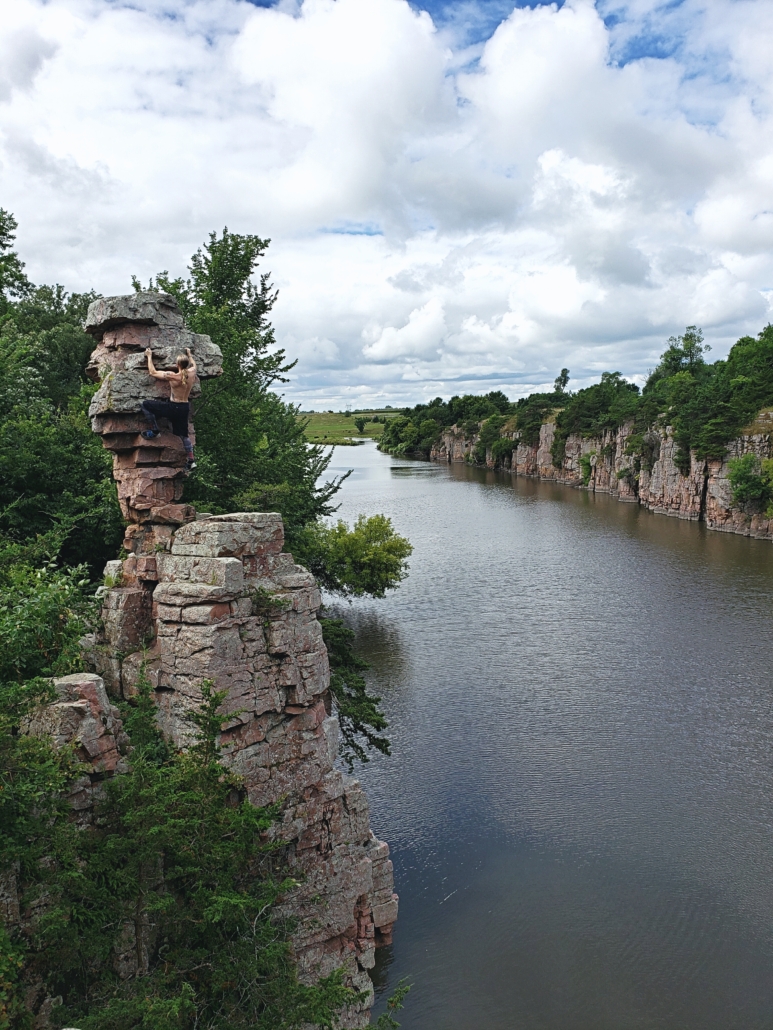
Since Parkour is supposed to get you from point A to point B, eventually you’ll probably need to go up, and that means climbing. Our beginner climbing skill set is designed to explain how to get from the ground to the top of any wall or obstacle.
We start with the basic wall run, running straight toward a wall and kicking it to get as high as possible (eventually the goal being to grab the top of the wall, but we go over that a bit later), which leads into a bit of a tangent of the tic-tac. A tic-tac in Parkour is any time you kick off an obstacle to change your direction. Since the wall run is changing your forward running momentum into upward momentum, it’s technically a tic-tac. Usually we mean diagonal running movement when talking about tic-tacs though, so we cover a simple one step diagonal tic-tac as a bit of a tangent from the wall run during our climbing classes.
Next up is the Cat Grab, one of the most iconic Parkour movements, as well as a basic introduction to the Cat Back. Then comes the fun part. With our goal of getting up on top of a wall or box, if you’re in your cat grab position that means you need to pull yourself up through a Climb Up. Now, basically no one is strong enough to do this when they first start training Parkour, so we use this opportunity to cover some exercise science and talk about how to get stronger and more explosive using basic exercises of pull ups, push ups,
and dips.
Finally we finish the climbing concepts with a Top Out, which is getting from a support position up to standing on top. We have 4 levels of Top Out, but at first we only cover the first couple. Level 1 is getting up by any means necessary including using elbows, knees, etc. We don’t actually allow people to climb like this at FoFa, so we immediately cover the level 2 top out – putting your foot on the outside of your hands and finishing the climb. After this you should have all the tools to fully climb up a box, so it’s time to put it all together and climb some boxes! At first just getting up a 5 or 6 foot tall box is great, but eventually the goal is to fully and properly climb something that is double your own height. This will take a lot of training though.
VAULTING
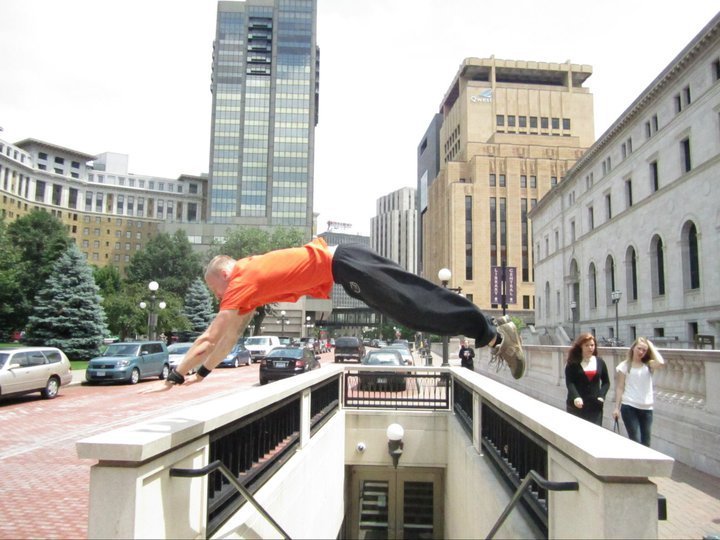
When most people think of Parkour, they immediately think of vaults so there’s no way we could have the best Parkour classes in the Twin Cities without teaching them. Some of the most recognizable motions in all of Parkour are vaults. A vault is getting over an obstacle with the assistance of your hands. You can use more than just your hands (feet, butt, etc.), but you have to use your hands or it becomes a hurdle or stride. There are billions of different vaults in the world of Parkour, but we consider just 5 of them to be the “basic” vaults. And we don’t even teach all of them in our beginner program.
We start with the Step Vault and Lazy Vault. These are the simplest to learn and can be used to teach a bunch of different movement concepts like hand and foot placements, different take-off ideas, directions of motion, and even proprioception. We teach 2 different variations of the Reverse Vault, with first sitting on the obstacle to get used to the rotation, and also a two handed variation that comes from the turn vault. Finally, the other basic vault we cover is the Kong, but in our beginner classes we only do a Kong up on an obstacle. We save the full Kong vault for our intermediate classes.
Beyond what we consider the basic vaults, we do cover some variations in our beginner classes as well. The speed vault and thief vault are introduced as variations of the step and lazy vaults. The turn vault is taught at ground level with the expectation shown that eventually it is meant to be done at height. And finally we go over the Step Down to show that vaults can be used to descend down off an obstacle as well as go over them. Sometimes we even combine the Kong Up and Step Down into the first double vault to use when going over wider obstacles.
ROLLING
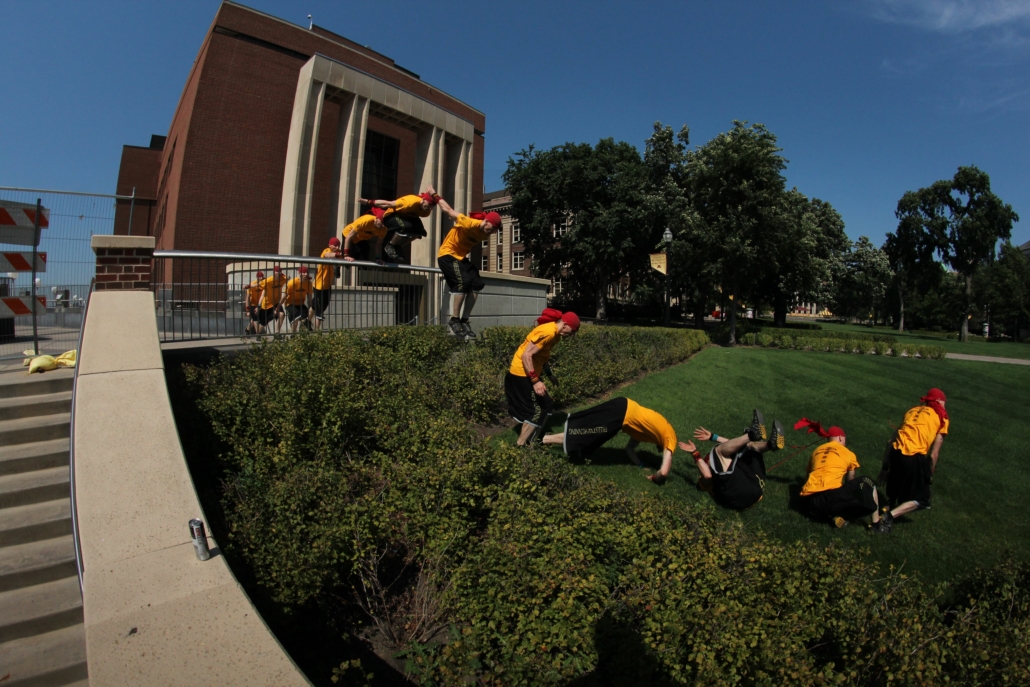
The shoulder roll is by far the most complicated movement in all of Parkour. It’s extremely difficult to learn properly and will likely take years of practice to perfect. You may have noticed that rolling was missing in our landing curriculum, and that’s because it’s so important that it gets a day completely to itself.
We start with learning the absolute basics of how to do a shoulder roll. There are a few different progression paths to get there, but for the most part we cover avoiding your head, pushing really hard with your hands, and keeping your feet symmetrically together. We also go over the fact that the roll isn’t meant to absorb impact, but instead it transfers your downward force into forward force going through a rotation. We emphasize getting length in your rolls and controlling the direction of the energy going into the roll. The shoulder roll is also one of the most difficult movements to teach because everyone will roll slightly differently based on their body.
After getting the basic roll down on a soft surface, we take all of our beginners to concrete to do at least one roll. This is to teach them the anatomy of where exactly to roll and avoid all the boney bits in your shoulder, back, and hip. Also this is to get them into practicing on hard ground. It’s impossible to learn a perfect roll on a soft surface.
After that we work on adding a little height to our shoulder rolls. We do small jumps off a three foot tall box as well as hanging in a gargoyle position on a seven foot tall box and dropping into the roll. It’s extremely important to keep beginners low on these as most people don’t really understand the exponential impact of gravity and they have seen videos of high level athletes doing huge jumps to roll. Many beginners will overestimate their abilities when they first start rolling.
Finally in our rolling classes we go over the backward shoulder roll. This is introduced as a way to save yourself if you’re falling backward. As we use this primarily as a falling technique, the most important part of the technique is not hitting your head on the ground. No matter how crap the rest of the roll looks, as long as you don’t hit your head you’re good!
FLOW
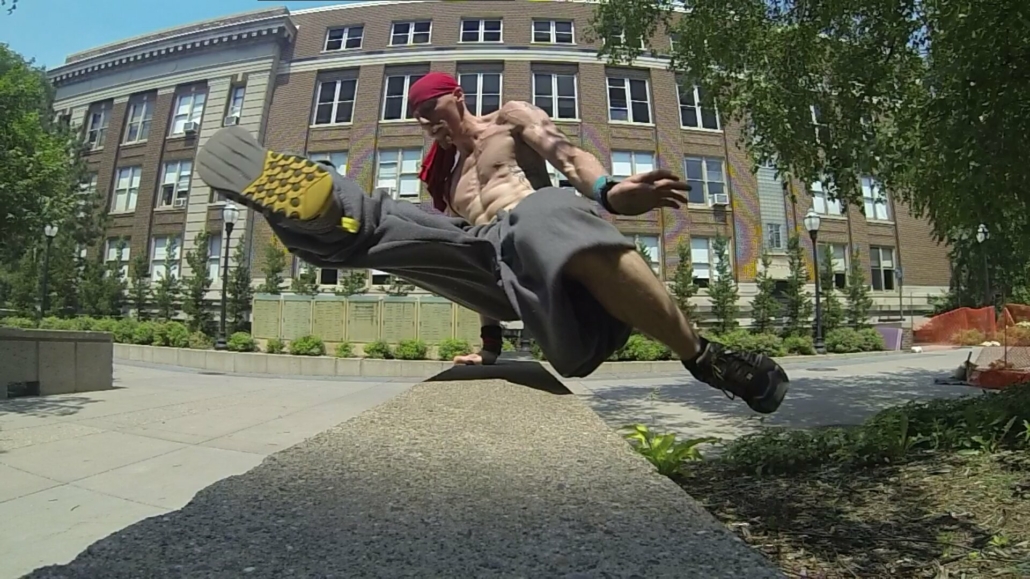
It’s extremely difficult to define “flow”. We know it’s extremely important in everything that we do, but can you put into words exactly what it is? We define flow very loosely with two basic concepts: continuous momentum and minimal steps. I’ll probably write an entire other blog on that, so for now let’s focus on the actual movements we teach in the beginner flow class.
We start with a new concept of reverse vaults. Every vault can be turned into a reverse version of that vault just by kicking backward instead of forward. We take the step vault and learn the reverse step vault and the lazy vault turns into a reverse lazy vault. We also combine the reverse variations with their regular vaults to make the step and lazy dances.
Then we move into some over/under movements with a lazy over to step under on a bar or a beam. The idea here is to be able to not only transition horizontally in your movement, but also up and down. We also teach the step vault to 360 under. These can be done with other vaults as well and students are often encouraged to make up their own combinations like these to start teaching some creativity.
Finally we teach a few random movements that would be used in freerunning style flow lines but not really in purist Parkour lines. We teach the turn up, coffee grinder, leg cut, and sit turn. After students have a grasp of these we play games of add-on to work on flowing different combinations together.
TUMBLING
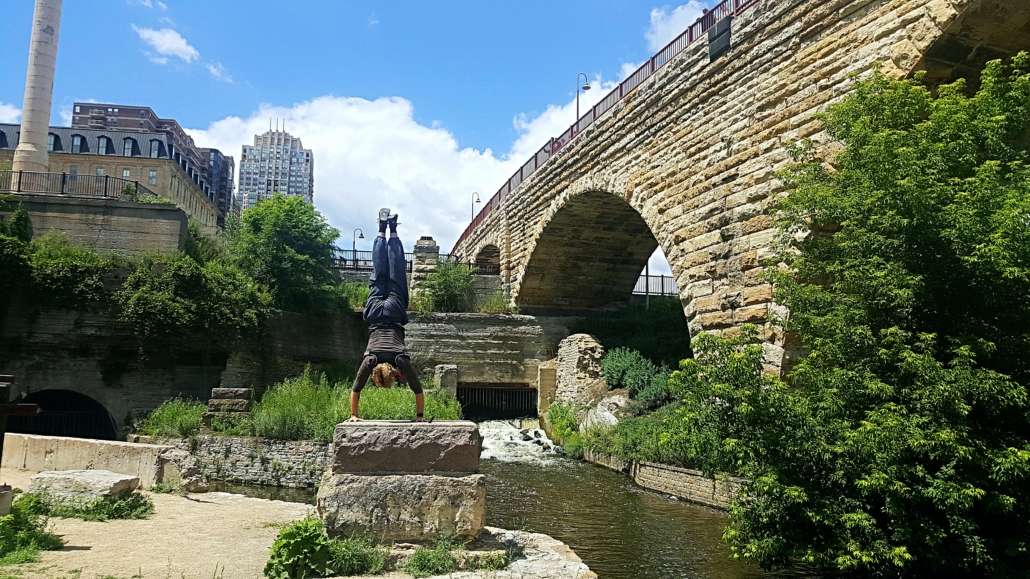
If you’re going to teach the best Parkour classes in the Twin Cities, at some point you’ll have to teach some flips, so that brings us to tumbling. Tumbling tends to be a very polarizing subject. It is either terrifying or extremely exciting depending on how comfortable a student is with going upside down.
Our beginner tumbling program starts by teaching the absolute basic straight, hollow, arch, tuck, straddle, and pike shapes. We go over exactly what these should look like and what they are used for.
The rest of the class is based on the three most simple acrobatic movements: the handstand, cartwheel, and rolls. For the handstands we start with basic rock ups in various shapes and some wall work.
Many new students can already do cartwheels and rolls, but we have 100% beginner progressions to get into these movements. Cartwheels are pretty simple and we really try to enforce proper hand positioning and directions of entry and exit. Rolling gets a little more in depth with forward rolls turning into dive rolls and sometimes even throwing front flips to the back on our big squishy pads!
Finally we get into a bit of bridge work on the wall and with some twisting. These concepts will turn into tricking movements like the gumbi and raiz… eventually.
BARS
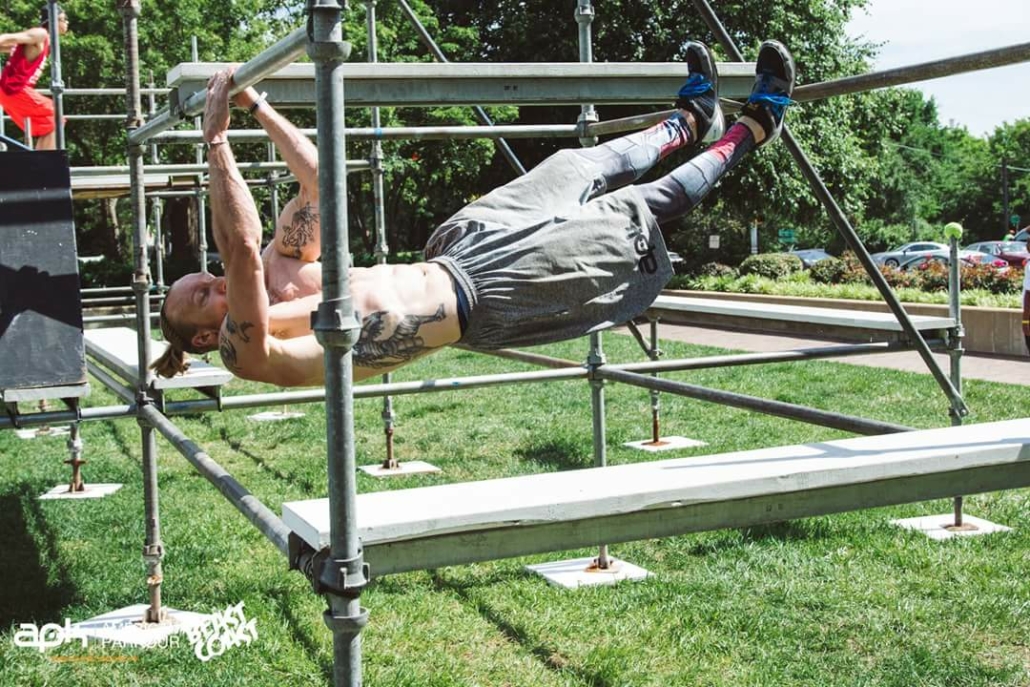
Bar stuff is almost always the most foreign of movement to new students. In the real world railings are something to avoid. Ex-gymnasts are pretty much the only people who have played on bars anywhere other than a tiny bit on the playground as a child.
We start off with some simple underbars. We talk about the regular underbar, bazooka underbar, 360 underbar, and step through underbar. All of these have different purposes, so it’s good to have a variety of these depending on the situation.
After that everyone should be pretty use to how the bars feel and how well they can hold themselves, so it’s time to get swinging. Focusing on safety, we make sure everyone has a good re-grip and is releasing in the back of their swing so they can see the ground as they land. Then we immediately go to releasing in the front and teach the lache to precision technique. We don’t expect anyone to perfect this, it’s really just an introduction.
We also teach what we call a “Russian Pull Through” which is often students first time going upside down and backward with a backflip motion, so it tends to be a favorite.
Finally (usually once students’ hands are hurting) we have a few moves we work on from a support position in the bar. Sitting on a bar and tipping over backward to a knee hang, a forward roll over the bar, and a simple cast. Combining all of these skills into our curriculum has helped us create the best Parkour classes in the Twin Cities area.
WALL TRICKS

Our wall tricks class is actually only half a class at the beginner level (there’s not a lot of stuff that beginners are ready for on a wall). So we also do half the class on twisting techniques, which don’t really fit into the other classes.
We start with twisting little 90 degree jumps and 180 jumps. We let any student who thinks they can go for 360, 540, or farther…but they will fall down eventually so we’re sure to take it slow. Then we take these twisting concepts and add them to precision jumps, wall runs, and cat grabs. With each technique focusing on controlling the twist rather than just throwing yourself around as fast as possible.
Then getting into actual wall tricks, we go over the basics of the wall spin and SUHPWG. We use the side of a tipped over trapezoid to teach these at an angle and then slowly raise the angle up during their training until eventually they can be done on a completely flat wall (not in the beginner class though). We also start teaching wall flip timers and usually spend a good deal of time on the wall flip technique as it’s something that is extremely popular and many people want to learn it.
And that’s our beginner curriculum in a nutshell. As I mentioned at the beginning of this, we teach based on technique mostly instead of other styles of Parkour coaching that can be based more on conditioning or creativity and individual problem solving. I believe that without a good base of simple Parkour techniques, it’s kind of pointless to try to get students to be creative and figure it out themselves, and conditioning should be used to supplement the technique training rather than the other way around.
If you’re interested in joining the best Parkour classes in the Twin Cities, be sure to check out Fight or Flight Academy! Keep training and as always…Remember Rule #8, DON’T DIE!

-Chad Zwadlo
P.S. – Want to try all of these skills, in our space, for free, with a coach’s help? Visit our First Timers page and book a free private lesson!




Leave a Reply
Want to join the discussion?Feel free to contribute!